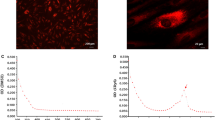Abstract
Several studies were undertaken to develop three-dimensional (3-D) cell culture models that allow conditions closer to the in vivo situation. To this end, alginate gels were tested as a 3-D cell culture model that might be useful in the study of the effects of UVA on human dermal fibroblasts. Cell culture in alginate gels and the irradiation conditions were optimized. Results showed that optimized cultures in alginate gels experienced considerable cell death on UVA irradiation compared to the classical monolayer cell culture. Viability tests (cell counting and neutral red assay) were performed to show that only UVA-irradiated alginate gels were responsible for this cytotoxicity. The implication of oxygen species in the phototoxicity induced by ultraviolet light has already been described; for this reason we investigated whether oxygen species were involved in the cytotoxicity induced by alginate upon UVA irradiation. It appeared that superoxide anion is not implicated
Similar content being viewed by others
References
Bell E, Ivarsson B, Merril C. Production of a tissue like structure by contraction of collagen lattices by human fibroblasts of different proliferative potential in vitro. Proc Natl Acad Sci USA. 1979;76(3):1274–8.
Borenfreud E, Puerner JA. A simple quantitative procedure using monolayer cultures for cytotoxicity assays. J Tissue Culture Methods. 1984;8:7–9.
Chang PL, Hortelano G, Tse M, Awrey DE. Growth of recombinant fibroblasts in alginate microcapsules. Biotechnol Bioeng. 1994;43:925–33.
Elsdale T, Bard J. Collagen substrata for studies on cell behaviour. J Cell Biol. 1972;54:626–37.
Enninga IC, Groenendijk RTL, Filon AR, van Zeeland AA, Simons JWIM. The wavelength dependence of UV-induced pyrimidine dimer formation, cell killing and mutation induction in human diploid skin fibroblasts. Carcinogenesis. 1986;7:1829–36.
Fremond B, Malandain C, Guyomard C, Chesne C. Correction of bilirubin conjugation in the Gunn rat using hepatocytes immobilized in alginate gel beads as an extracorporeal bioartificial liver. Cell Transplant. 1993;2:453–60.
Gaboriau F, Morlière P, Marquis I, Moysan A, Gèze M, Dubertret L. Membrane damage induced in cultured human skin fibroblasts by UVA irradiation. Photochem Photobiol. 1993;58:515–20.
Grandolfo M, D'Andrea P, Paoletti S et al. Culture and differentiation of chondrocytes entrapped in alginate gels. Calcif Tissue Int. 1993;52:42–8.
Guo J, Jourdian GW, MacCallum DK. Culture and growth characteristics of chondrocytes encapsulated in alginate beads. Connect Tissue Res. 1989;19:277–97.
Liebsch M, Spielmann H, Balls M et al. First results of EC/COLIPA validation project “in vitro phototoxicity testing”. In: In vitro skin toxicology. New York: Mary Ann Liebert Publishers; 1994:243–51.
Martinsen A, Skjak-Braek G, Smidsrod O. Alginate as immobilization material. 1. Correlation between chemical and physical properties of alginate gel beads. Biotechnol Bioeng. 1989;26:53–8.
Morlière P, Moysan A, Sanctus R, Hüppe G, Mazière JC, Dubertret L. UVA-induced lipid peroxidation in cultured human fibroblasts. Biochim Biophys Acta. 1991;1084:261–8.
Peak JG, Peak MJ, Sikorski RS, Jones CA. Induction of DNA-protein cross-links in human cells by ultraviolet and visible radiations: action spectrum. Photochem Photobiol. 1985;41:298–302.
Pick E, Keisari Y. Superoxide anion and hydrogen peroxide production by chemically elicited peritoneal macrophages—induction by multiple nonphagocytic stimuli. Cell Immunol. 1981;59:301–18.
Rosenstein BS, Ducore JM. Induction to DNA strand breaks in normal human fibroblasts exposed to monochromatic ultraviolet and visible wavelengths in the 240–546 nm range. Photochem Photobiol. 1983;38:51–5.
Scharffetter K, Wlaschek M, Hogg A et al. UVA irradiation induces collagenase in human dermal fibroblasts in vitro and in vivo. Arch Dermatol Res. 1991;283:506–11.
Schlumberger W, Thie M, Rauterberg J, Kresse H, Robenek H. Deposition and ultrastructural organization of collagen and proteoglycans in the extracellular matrix of gel-cultured fibroblasts. Eur J Cell Biol. 1989;50:100–10.
Schor SL. Cell proliferation and migration on collagen substrata in vitro. J Cell Sci. 1980;41:159–75.
Thie M, Schlumberger W, Rauterberg J, Robenek H. Mechanical confinement inhibits collagen synthesis in gel-cultured fibroblasts. Eur J Cell Biol. 1989;48:294–302.
Trump BF, Berezesky IK. Ca2+ mediated cell injury and cell death. FASEB J. 1995;9:214–28.
Tyrell RM, Pidoux M. Singlet oxygen involvement in the inactivation of cultured fibroblasts by UVA and near visible radiations. Photochem Photobiol. 1989;49:407–12.
Author information
Authors and Affiliations
Rights and permissions
About this article
Cite this article
Pascual Le Tallec, L., Korwin-Zmijowska, C. & Adolphe, M. Limitations of alginate gels as a culture model for the study of the effects of UVA radiation on human dermal fibroblasts. Cell Biol Toxicol 13, 95–102 (1997). https://doi.org/10.1023/B:CBTO.0000010394.58263.2c
Issue Date:
DOI: https://doi.org/10.1023/B:CBTO.0000010394.58263.2c




